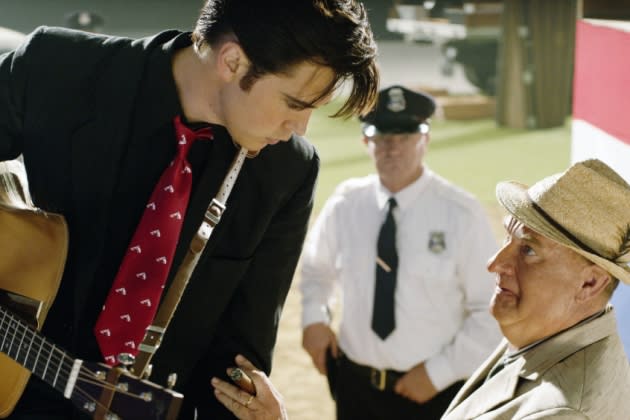‘Elvis’ Cinematographer on Recreating the King’s Vegas Showroom for Baz Luhrmann Biopic

In recreating Elvis Presley’s famous ’68 Comeback Special, “Elvis” cinematographer Mandy Walker spent hours watching and examining old footage to faithfully reproduce certain shots and lighting changes for Baz Luhrmann’s biopic.
Walker’s set replicating the Vegas showroom at the International Hilton, where Presley had his residency, is her proudest accomplishment from the film. “That set was gigantic. We had a full-on concert lighting set-up that we had to reproduce,” Walker says.
More from Variety
At one point, Walker and the film’s gaffer had considered bringing in professional concert lighting to program and order the lights, but she decided it was a job they could pull off. So, Walker had traditional single-lamp par can lights flown to the film’s set in Australia.
“We reproduced it all right down to the follow spots and the backdrop colors,” Walker says with pride. “There was a stills photographer, Alfred Wertheimer, who traveled with Elvis during the 1950s. I looked at his work, and had all these images in the back of my mind. When you add in all these other elements — the art department, costumes and hair and make-up — they all come together in harmony to become the visual language of the film.”
To finish the lighting, Walker says she “added modern LED lighting to smooth it out and make sure you could see Austin’s face properly, or we’d use LED to complement what we had.”
Luhrmann and Walker spent a long time in prep discussing not just the script, but the emotional journey of the characters and how the filmmaker wanted to present that to the audience. Walker says Luhrmann liked to keep the camera moving — a lot. But when there were scenes with Presley and his mother, Gladys (Helen Thomson), the camera slowed down. Says Walker, “In those scenes with Elvis and his mother, the camera settles and the two are centered in the frame. We push the depth of field to be more shallow.”
Shooting on the Alexa 65mm helped Walker achieve that intimacy. Walker says, “It’s the best format… for intimacy because you can narrow the depth feel down to be very close to a character and not feel what’s going on behind. It’s about focusing the audience on them.”
Toward the end of the film, things start to take a dramatic turn as Elvis realizes he is stuck with manager Colonel Tom Parker (Tom Hanks) and must stay in Vegas to complete the residency. When his father and business manager Vernon (Richard Roxburgh) comes to visit, Walker shifted the lighting drastically. “We hardly had any light on [Austin], and we wanted it darker to feel how closed in he was,” she explains.
With a focal length of up to 160mm, the Petzval lens was key for flashback scenes. Walker had one custom-made for the film. “Especially with the morphine-related retelling of stories, we would use that to put the audience in the center, and the outside would drop out of focus. It would create that feeling of disorientation,” Walker says.
Best of Variety
Sign up for Variety’s Newsletter. For the latest news, follow us on Facebook, Twitter, and Instagram.

 Yahoo Movies
Yahoo Movies 